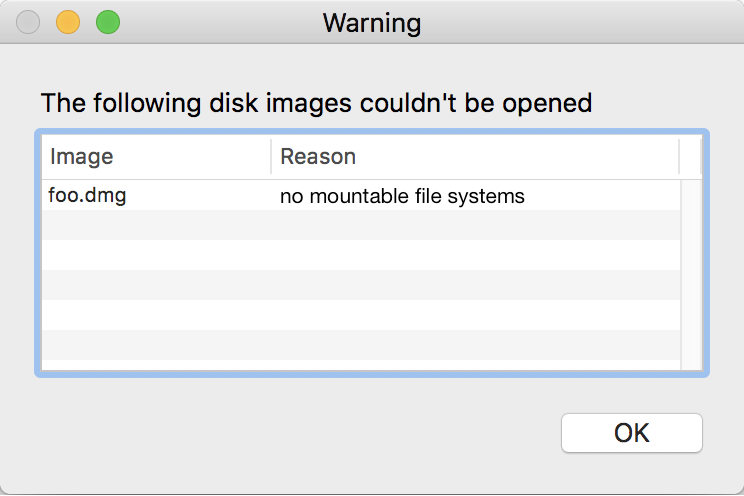
- #Debian install dmg wrong fs type full version
- #Debian install dmg wrong fs type mac os x
- #Debian install dmg wrong fs type install
- #Debian install dmg wrong fs type code
- #Debian install dmg wrong fs type iso
Please read the "Supported Linux Distributions" chapter in README.
#Debian install dmg wrong fs type install
The commands to install just the first prerequisites follow.

It will be removed some day from FFmpeg API.įor optional DVD support you need the following librariesįor optional Bluray support you need the following library One of these is required, preferably libswresample as libavresample is deprecated.

Building FFmpegfs yourself PrerequisitesįFmpegfs uses FFmpeg lib for decoding/encoding.
#Debian install dmg wrong fs type code
It is available as either the latest stable version or the latest code from GIT. Their verifies just says everything is working as intended.Sudo apt-get -t buster-backports install ffmpegfsįor Arch Linux and Manjaro, it can be found in the Arch User Repository (AUR). I can't find anything conclusive in the wiki, nor does gdisk or parted find anything wrong. EXT4-fs (sdb3) group descriptors corrupted! Using dmesg | tail brings up more entries with pretty much the exact same message: In some cases useful info is found in syslog - try dmesg | tail or so. Since a DMG is a disk image, I tried to mount it, but mount does not seem to recognize its format. I want to install a dmg file on a remote server. Dmg2img -v -i /path/to/imagefile.dmg -o /path/to/imagefile.iso.
#Debian install dmg wrong fs type iso
Mount: wrong fs type, bad option, bad superblock on /dev/sdb3, missing codepage or helper program, or other error. Sudo apt-get install dmg2img Convert DMG image file to ISO file. EXT4-fs (sdb3): group descriptors corrupted! EXT4-fs (sdb3): ext4_check_descriptors: Block bitmap for group 0 not in group (block 4294967295)! wrong fs type, bad option, bad superblock on /mnt/sdf1/mp3base1, missing codepage or.
#Debian install dmg wrong fs type mac os x
An fstab line with fuse.ffmpegfs file system fails with a strange message when attempted to mount with 'mount -av'. Code: sudo mount -t hfsplus Mac OS X Install DVD.dmg /mnt/usb/ sudo password for jason: mount: wrong fs type, bad option, bad superblock on /dev/loop0, missing codepage or helper program, or other error In some cases useful info is found in syslog - try dmesg tail or so. Now onto my current issue mounting the partitions. FFmpegfs can be installed on Debian 10 Buster from Buster Backports and sid (which is not recommended and therefore not described here).

Worked smoothly, the repair function seemed to have worked. Which could imply it was meant for a dualboot system, but it didnt seem likely to me. Failure to do so will result in an unbootable installation Mac OS X 10.5 (Leopard) introduced the concept of sparse-bundle disk images, where the data is stored as a collection of small, fixed-size band-files instead of as a single monolithic file.
#Debian install dmg wrong fs type full version
If a new UEFI system partition has been created on a UEFI/GPT system, it must be formatted with a fat32 or vfat32 file system. ec2-user lsblk NAME MAJ:MIN RM SIZE RO TYPE MOUNTPOINT xvda 202:0 0 8G 0 disk xvda1 202:1 0 8G 0 part / xvdf 202:80 0 8G 0 disk xvdf1 202:81 0 8G 0 part xvdg 202:96 0 8G 0 disk xvdg1 202:97 0 8G 0 part xvde 202:64 0 8G 0 disk xvde1 202:65 0 8G 0 part /home/ec2-user/xvde1 ->I was able to mount this one successfully. Debian Install Dmg Wrong Fs Type Mac Os 11 Download Dmg For Cats Mac Cleaner Free Trial Os X Leopard Dmg Cloudconvert Dmg To Zip The Sims 4 Free Download Full Version Mac No Survey Mac Os 10.8. FUSE filesystem for reading macOS sparse-bundle disk images. Everything shows up normally using lsblk, gdisk and partered. I let it do its thing using the repair different repair functions which seemed to do the trick.

Gdisk prompted me that the backup table partition was corrupted and would have to write a new one. Now, after this my partitions wouldnt show up properly (corrupted filesystem). Until finally making the root partition with dev/md1 /dev/md2 /dev/md3 /dev/md4 i can mount the partition via command line very easily. here is my RAID partitions layout and size is 500GB each made on GPT. Failure to do so will result in an unbootable installation. Subject: mount fail via fstab but working with command line. If a new UEFI system partition has been created on a UEFI/GPT system, it must be formatted with a fat32 or vfat32 file system. (parted) mkpart primary linux-swap 513M x.0G Although in order to do that, I kinda need to actually get to the installation part. Used parted according to the wiki and used:įollowed up by making a 4gig'ish swap partition using (don't remember the exact point I drew it to, but the swap is 4.2G) Since I'm using GPT and planning on using Grub, I'll have to create a UEFI bios partition. Since I have a UEFI bios (and I'm not dualbooting with windows) I'm supposed to use GPT. I'll just walk you through what I did and my thought process doing so you'll know when I made mistakes.įollowing the beginner guide, I started off with lsblk to find my harddrives /dev/sda and /dev/sdb (sdb is my ssd and will be my root/system drive). Although in order to do that, I kinda need to actually get to the installation part.


 0 kommentar(er)
0 kommentar(er)
